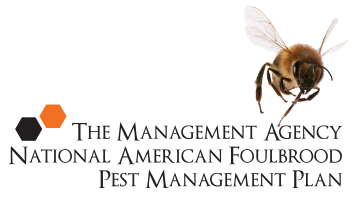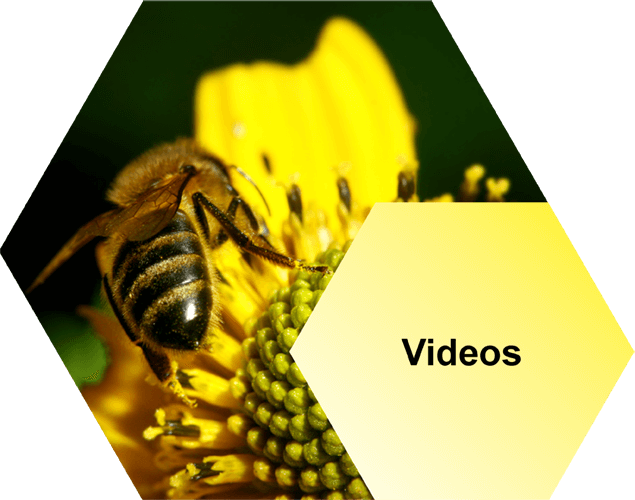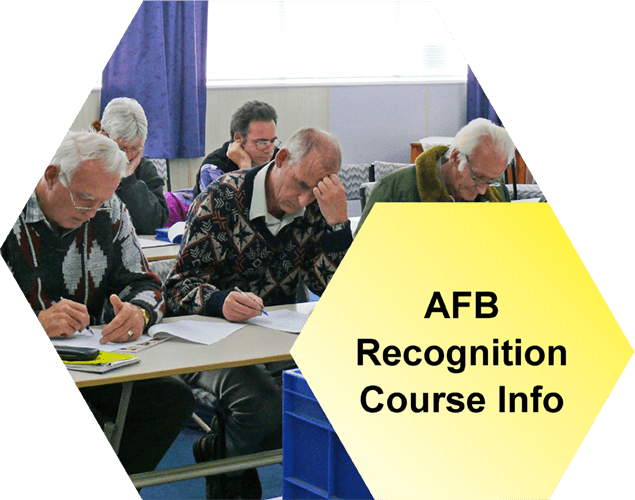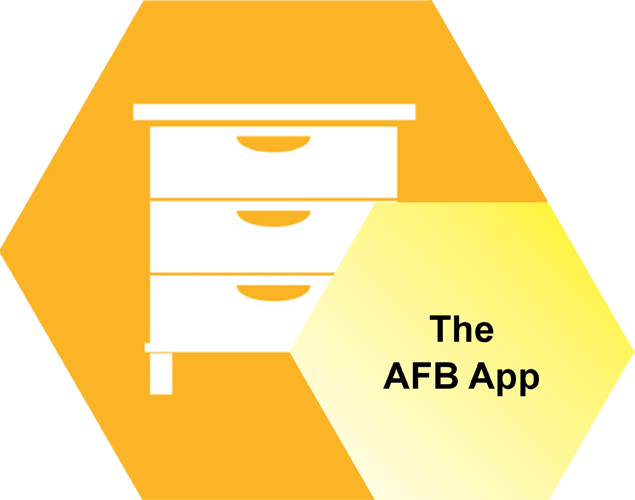Sacbrood
What is sacbrood?
Sacbrood is a viral disease that affects honey bee brood. It is often confused with AFB, since brood killed by the virus always dies at the late larval (prepupal) stage, when the larva is fully extended along the bottom wall of the cell. This is the same position in which a larva infected with AFB dies. Unlike AFB, however, sacbrood infected brood never die in the pupal stage.
Cells
Cells containing sacbrood can be either capped or uncapped. If the cells are capped, perforations in the cappings appear in the same way as for AFB, since in both cases the perforations are created by house bees that have detected diseased larvae underneath.
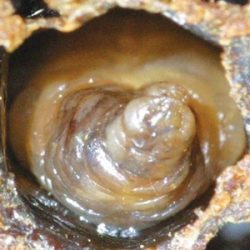
Larvae
Decaying larvae killed by sacbrood tend to remain more rounded in shape than those killed by AFB, at least in their early stages of decomposition. The skins of sacbrood infected larvae become tough and plastic-like (Fig. 43), and retain the segmentation visible in healthy brood. AFB infected larvae do not show this clear segmentation.
Colour changes
Sacbrood infected larvae go through a series of colour changes, from yellow, to brown, to grey, and finally to black. AFB infected larvae also go through a series of colour changes, but the change is from light coffee-brown colour to darker coffee-brown colour, and finally to black. Sacbrood infected larvae at the brown colour stage are the ones most often confused with AFB infected larvae.

Inspect the head
In sacbrood infected larvae, the head-end of the larva usually remains darker than the rest of the body, and the head-end is often raised (Fig. 44).
AFB infected larvae do not generally display two-tone colouration, although at the onset of the final drying down of AFB larva into scale, the head-end of the larvae can become drier than the rest of the body, giving it a darker appearance.
The head-end is not raised in AFB infected larvae.
Inspect scale
Unless house bees remove them, sacbrood infected larvae eventually dry down to black-coloured scale, which are similar in appearance to AFB (although no pupal scale or associated tongues are ever found). Unlike AFB scale, sacbrood scale can be easily removed from the cell wall, often in one piece. Sacbrood scales are also generally found only in colonies suffering heavy infections. Such infections are rare.
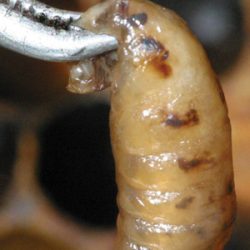
Larvae removal
At the early stage of decomposition, larvae infected with sacbrood can usually be removed with a stick or twig as whole larvae (Fig. 45), and will hang in a sack-like fashion (hence the name “sac” brood). If the larva is punctured, a watery fluid will come out. AFB infected larvae do not display such symptoms.
Ropiness test not to be relied on in this case
Beekeepers often use the ropiness test when they find sacbrood infected larvae in the brown colour stage (after the larvae have collapsed, but before drying down to scale). It can be difficult to make a visual diagnosis of such larvae, since the symptoms so closely resemble AFB. Generally, sacbrood infected larvae at this stage will not show the degree of roping associated with AFB and the rope will be lumpy and uneven in colour. The roping is probably caused by other bacteria feeding on the larval remains.
Because ropiness can also be variable in AFB infected larvae, it is important to look for other contrasting symptoms when making a differential diagnosis for sacbrood. The remainder of the brood should be checked carefully for more definitive AFB symptoms (and especially pupal scale). If no further symptoms can be found, a sample of the suspect (roping) larva should be taken for laboratory testing (see laboratory diagnosis of AFB).
Some hives are more susceptible to sacbrood than others. Requeening will normally cause the symptoms to disappear.
Unlike AFB, sacbrood does not affect pupae. Sacbrood larvae do not rope out like AFB, and have a watery consistency.
Take the AFB 5 minute quiz
How well do you know what you need to know about AFB and beekeeping? Take our short quiz and find out.
Videos
Our videos cover everything from your legal obligations to how to recognise AFB, collecting cell and bee samples and more.
Symptoms
There’s a lot of good information here, telling you everything you need to know about recognising AFB: the visual symptoms, smell of AFB and more.
Inspection and Diagnosis
Successfully eliminate AFB by telling the difference between symptoms of AFB and other brood diseases in the hive. We tell you the best methods for inspecting your hives.
The Law
New Zealand beekeepers have a number of legal obligations that must be met regarding AFB disease. Read the shortened list in summary, here.
Elimination
Most hives become infected because bees, honey or equipment have been put into a hive from another hive that is infected with AFB. Lower your chances of an AFB infection by reading this section.
AFB Recognition Course Info
Find out when the next AFB Recognition and Competency Courses, or Refresher Courses are available. These are held throughout the year in various New Zealand locations across the South Island and North Island.
The AFB App
Follow the link below to open the App. Once open to save to your device you need to bookmark the URL on your phone so you can find it easily again. Please click here to open.
